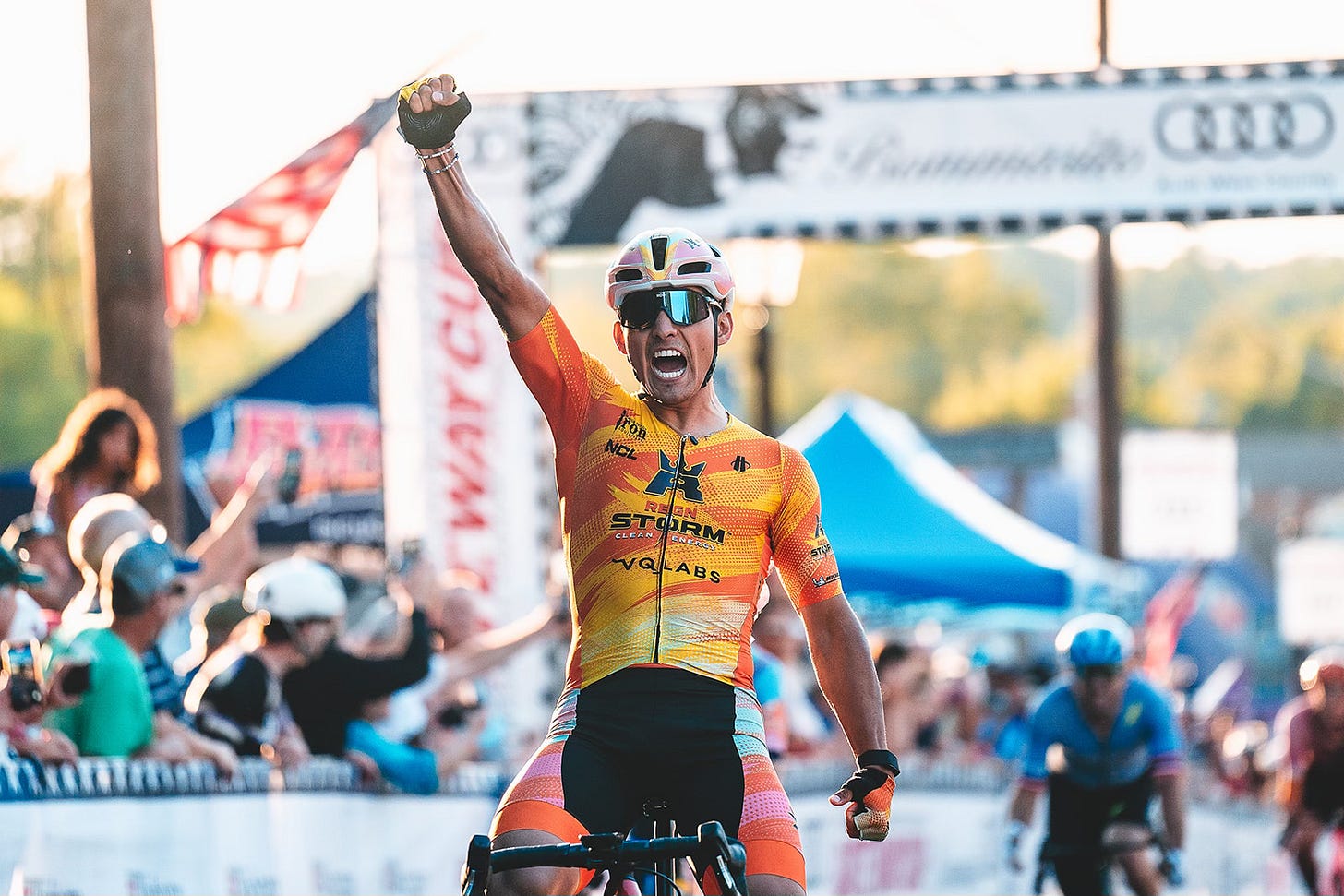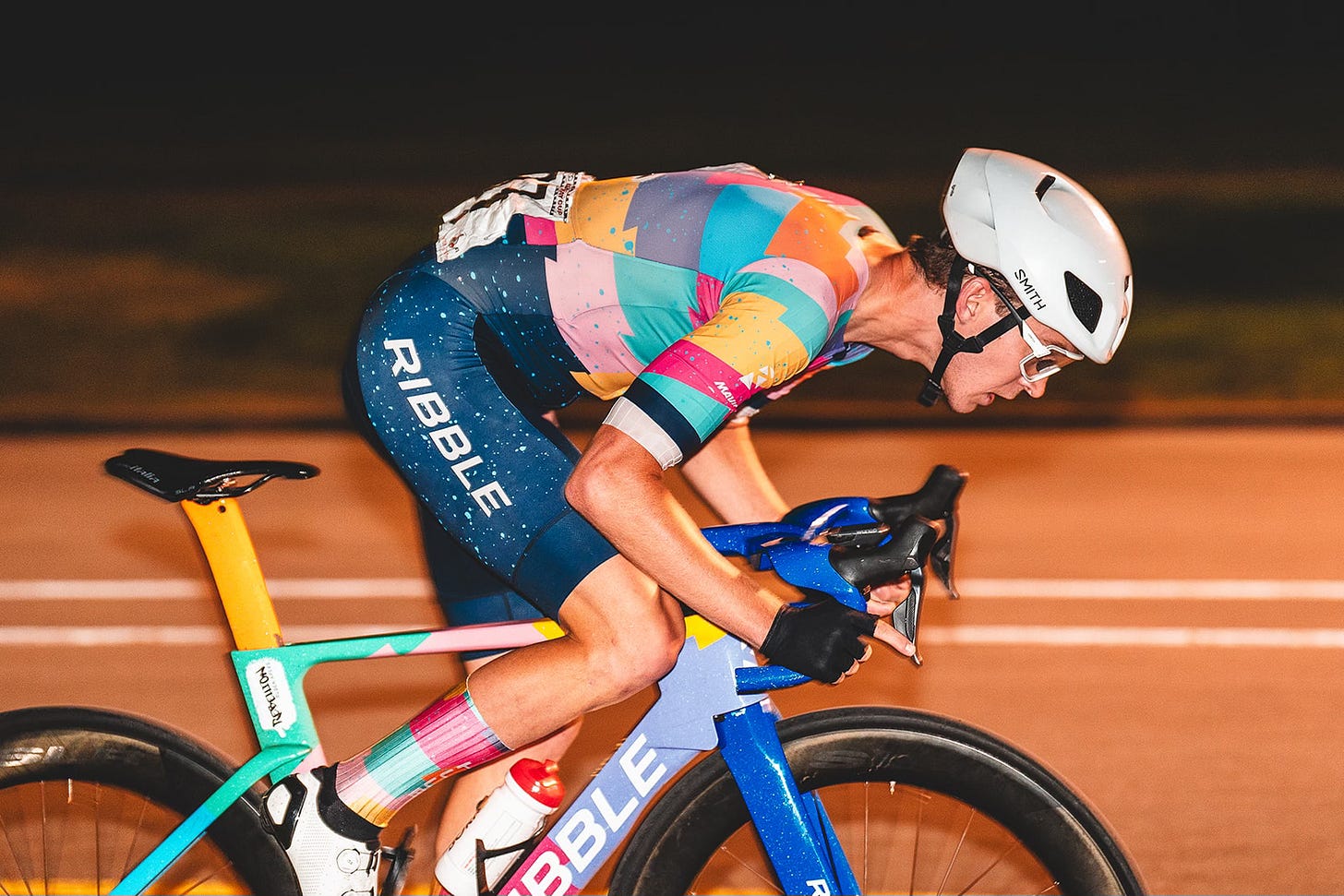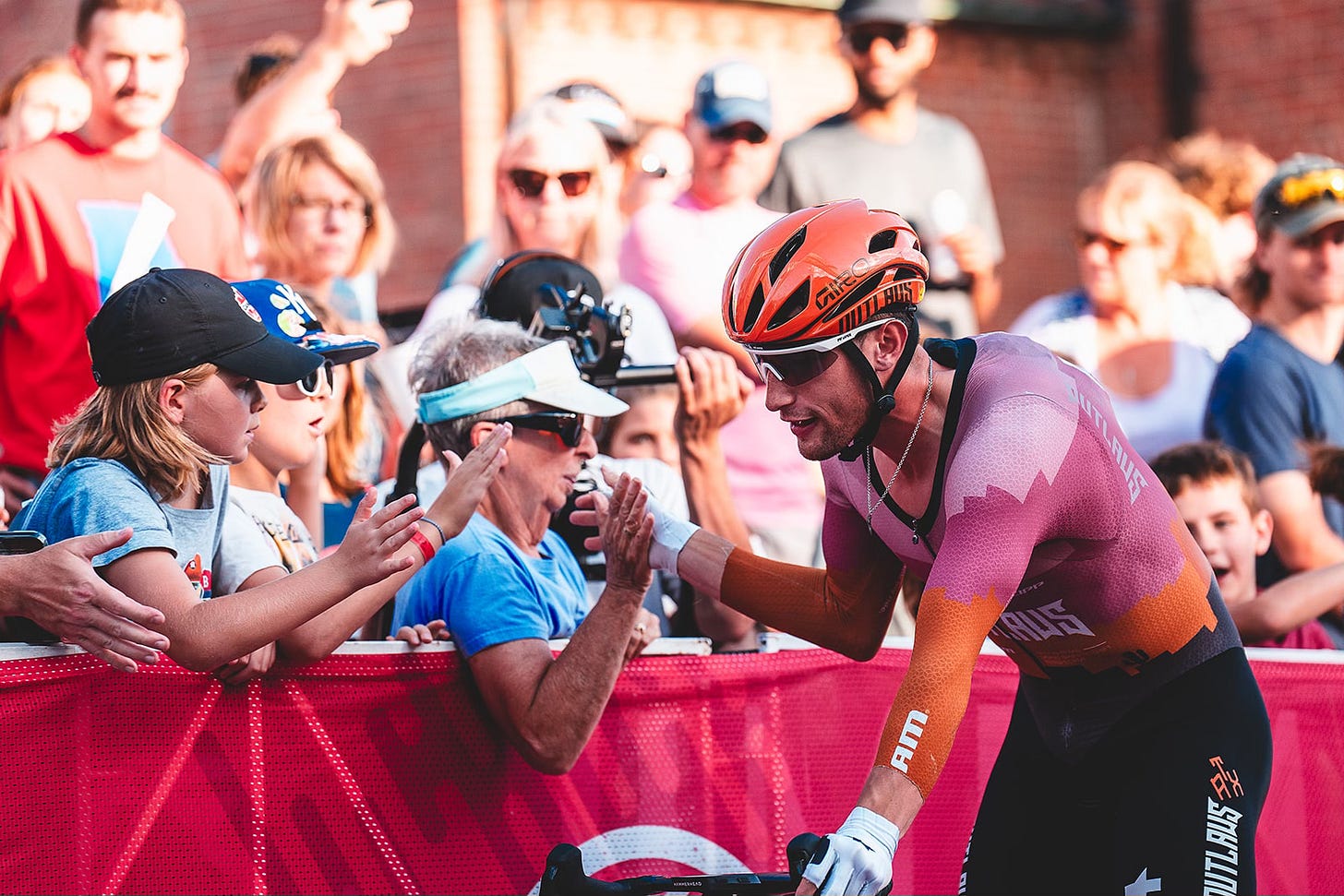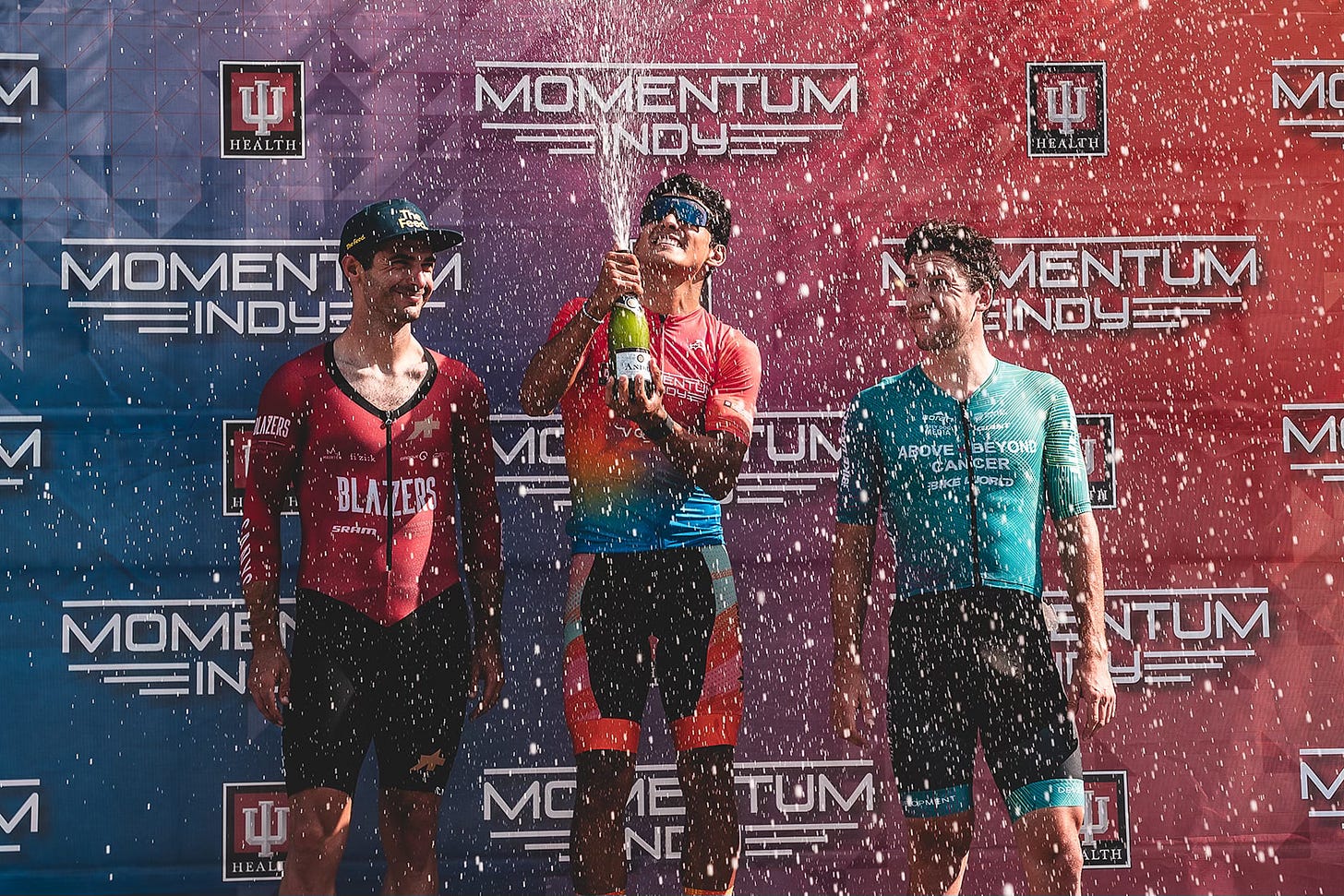In this article, we review the 2024 men’s domestic racing results as we did for the women's field previously. For those unfamiliar with our method, to create The Medal Count, we tracked the podium finishers at the top 19 American events in 2024 (it would have been the top 20, but Joe Martin was canceled). We assigned 3 points to P1, 2 to P2, and 1 to P3. That’s it, nothing fancy. The 19 events broke down into 61 racing opportunities— 45 criteriums, 3 time trials, and the remaining 10 were road races.
One immediately apparent takeaway was that, whereas the women’s field could be divided into three tiers of team performance, the men’s season was a tale of two top teams. To say this year was dominated by Project Echelon and REIGN Storm is an understatement. Project Echelon opened the season with an unprecedented show of force at Tucson Bicycle Classic, Redlands, and Tour of the Gila. The top-ten-ranked UCI Continental team based in Wisconsin turned everything it touched into gold.
Not only did they win the GCs at the three major stage races, but they won the vast majority of the stages at these races as well. The stage wins were spread out over multiple riders, including Tyler Stites, Brendan Rhim, Scott McGill, and Cade Bickmore. Tyler Stites put an exclamation mark on the team’s stage race superiority by capturing his third Redlands Bicycle Classic overall win in a row, joining Chris Horner as the only rider to accomplish the three-peat.
Echelon’s singular commitment to victory was on display again at Criterium Nationals in West Virginia. In rain-soaked conditions, Echelon lined up its nine riders at the front of the field from the first lap and effectively controlled it throughout. Even a crash from trusted leadout rider Sam Boardman with a lap to go couldn’t loosen the team’s grip on the race. The end result was a win for Stephen Bassett, and a full sweep of the podium with Rhim and McGill finishing behind him.
However, as Echelon was heating up and preparing for an international UCI campaign, REIGN descended on the criterium scene. Echelon competes in more traditional, almost demure shades of navy blue that seem to match their disciplined, methodical racing style— some would even call it mindful. On the other hand, REIGN, with its hi-viz kits, immediately presents a more punk-rock image. Combine that with their knack for lighting things up late in a race and the REIGN squad seemed like the perfect protagonist for the hot summer nights of crit season.
They backed the image up with results too. They swept the podium in the individual standings during the American Criterium Cup and absolutely destroyed the hopes and dreams of their competition in the ACC team overall as well. Outside the ACC, REIGN’s record was jaw dropping. They won both days of Indy, three of out of four days at Gateway, three days of TOAD, and Littleton, Boise and Sunny King.
When REIGN won there was also a good chance that at least one other spot on the podium would also be in a yellow/orange jersey— Indy, Gateway, Boise, Chicago, Littleton are just some examples. The squad had numerous weapons to utilize too. Alfredo Rodriguez was clearly the main sprinter with nine wins; but Jordan Parra had four wins, and Fergus Arthur would add another pair on technical courses at Lake Bluff and Brookfield. Beyond just the top steps the team also had perennial legend Danny Summerhill adding numerous seconds and thirds to their total.
However, labeling one or the other as the best team is a huge challenge as there was only one race weekend where Echelon and REIGN raced head-to-head— Armed Forces. In that weekend, the two squads would split the wins with Alfredo Rodriguez of REIGN taking the win at Crystal City in a messy field sprint and Brendan Rhim of Echelon soloing in the final ten laps from a long-distance breakaway to win Clarendon. On the first day Echelon’s McGill would finish third with two REIGN riders rounding out the wide angle podium. At the 100km Clarendon, Rhim’s teammate Sam Boardman would finish third and Rodriguez would finish fourth as the only REIGN rider on the podium.
During the early half of the season when stage races dominated out west, the only two squads that seemed capable of competing with Echelon were Team California and Team Medellin. Admittedly, had the NCL not completely collapsed early in the year, there was a chance that the Denver Disruptors could have offered more competition. Yet, it took the rest of the peloton until criterium season to gain traction against the boys in blue.
What could be called a missed opportunity, or simply a lack of funding was Ribble Rebellion. Joe Laverick’s squad of brightly-colored riders were galvanized behind standout performances by Cole Davis at Redlands and a team performance during Spartanburg that left even REIGN without an answer. However, after Davis’ second place at Tulsa Tough’s legendary Cry Baby Hill the squad lost momentum. With more funding and more race-starts throughout crit season perhaps it would have been their multi-colored kits and bikes that would have featured all over our Insta feed.
Similar commentary can be made about DCC and MitoQ-New Zealand Cycling Project, a pair of squads from across different oceans that lit up American crit racing in the brief periods they were stateside before returning home. They gave us incredible moments like Moritz Augenstein’s, DCC, win at day two of Tulsa in the Arts District; or the sheer joy of Marshall Erwood and James Gardner, MitoQ, going 1-2 at Northbrook during Chicago Grit.
This brings us to the breakthrough performances of the season. This is a group of riders and teams that emerged in the second half of the season and shook things up right when we were afraid crit season was going to get stale. We all recall that just prior to Tulsa Tough there was a huge shake up among the three Williams Racing squads and riders were apparently involuntarily shuffled among the teams with little notice. This would lead to crowd favorite Brendan “Monk” Feehery moving from the Blazers to the Austin Outlaws among other personnel shifts.
That shift would lead to the breakthrough of one of the most impressive riders of 2024— Lucas Bourgoyne. The man was a legend and a road warrior. He has already raced more than 70 times this year, and as a Texan he is likely to find more late season racing because they don’t seem to believe in an offseason there. He tasted his first bit of glory during Speed Week and Easton Twilight which must have wetted a long-dormant appetite, because he went on a complete tear from that point.
When it came to Medal Count events he started appearing on the podium at TOAD. He then became a staple on the podium during Chicago Grit winning back-to-back at Lake Ellyn and Winfield, two courses that could not be more different from each other. He would conclude the year with a solid run at Gateway with podiums on days two and four, before taking a second place at Bucks County.
Matching Bourgoyne, race-for-race and podium-for-podium was Ben Oliver of Above and Beyond Cancer. Oliver was a touch more selective in his racing and focused more on Mid-West classics. While not a Medal Count event, anyone who podiums Snake Alley will get our attention. Oliver’s first major podiums were a pair of third places at Indy and he followed that up with a run for the ages in Chicago. He would win Elgin and Fulton Market at Chicago Grit; both races requiring power and technical riding ability. After finishing second at Littleton, next up was Gateway, where he finished second at Lafayette Park. Oliver would also go on to get third the next day at Francis Park.
The men of Rockland Development, Clever Martinez and Marcos Mendez, quietly had their own breakthrough seasons. Mendez, a complete unknown prior to Clarendon, where he finished second, became the season's dark horse. Winning up the leg breaker hill at West Dundee during Chicago Grit is something most riders would remember as a career-defining moment. However, his win at Bucks County from a gutsy and determined move, will be spoken about in hushed tones for years to come.
Last but certainly not least among the top ten teams overall was Work Hard Be Humble, who brought swagger to the late-season races along with their signature all-white/gold kits. Cesar Marte taking the win at Somerville on a rainy day for this fledgling squad would have made the season. However, Preston Eye and Juan Arango's rides on the live stream at the Giro della Montagne in the closing laps were phenomenal and only added to the team’s ascendancy.
What can be taken away from all of this data? Unsurprisingly, as one of the top ten UCI Continental teams in the world, Echelon dominated stage race season. With Stites moving on to the Pro Continental team Caja Rural next year, Echelon could be expected to see a lull in 2025. But the Wisconsin-based squad will still like their odds with Rhim and McGill on the team and the results their other riders like Laurent Gervais tallied just outside of The Medal Count positions. They will also look to bolster their squad with off-season signing from the now defunct Ribble.
In addition, REIGN, which has grown from a scrappy upstart Best Buddies squad that periodically challenged L39ion’s hegemony in 2021, has very much arrived as the team to beat in races 75 minutes or less. For Echelon and REIGN, their dominance is not the product of one or even two riders but rather full squads netting podiums. This should mean resilient success in 2025, even if either squad loses a key rider or two.
What is also encouraging is the parity that comes from the teams in places 3-10 with podiums spread out among multiple teams and riders. You have young riders like Davis, Bourgoyne, and Mendez; along with veterans like Monk and Summerhill that can balance each other out and provide energy and guidance. What the data ultimately demonstrates is a rather solid racing future.
Photos by Kai Caddy.











